A popular bike route in north Portland is about to see a significant change. The Portland Bureau of Transportation plans to install a bike box and will prohibit right-turn-on-red on North Ainsworth Street at Interstate Avenue.
The plans were posted on the Facebook page of the Ockley Green Middle School Community Forum Facebook page.
PBOT Neighborhood Greenways Program Coordinator Scott Cohen wrote in the message that, “The project will improve safety and close a gap in the transportation system.”
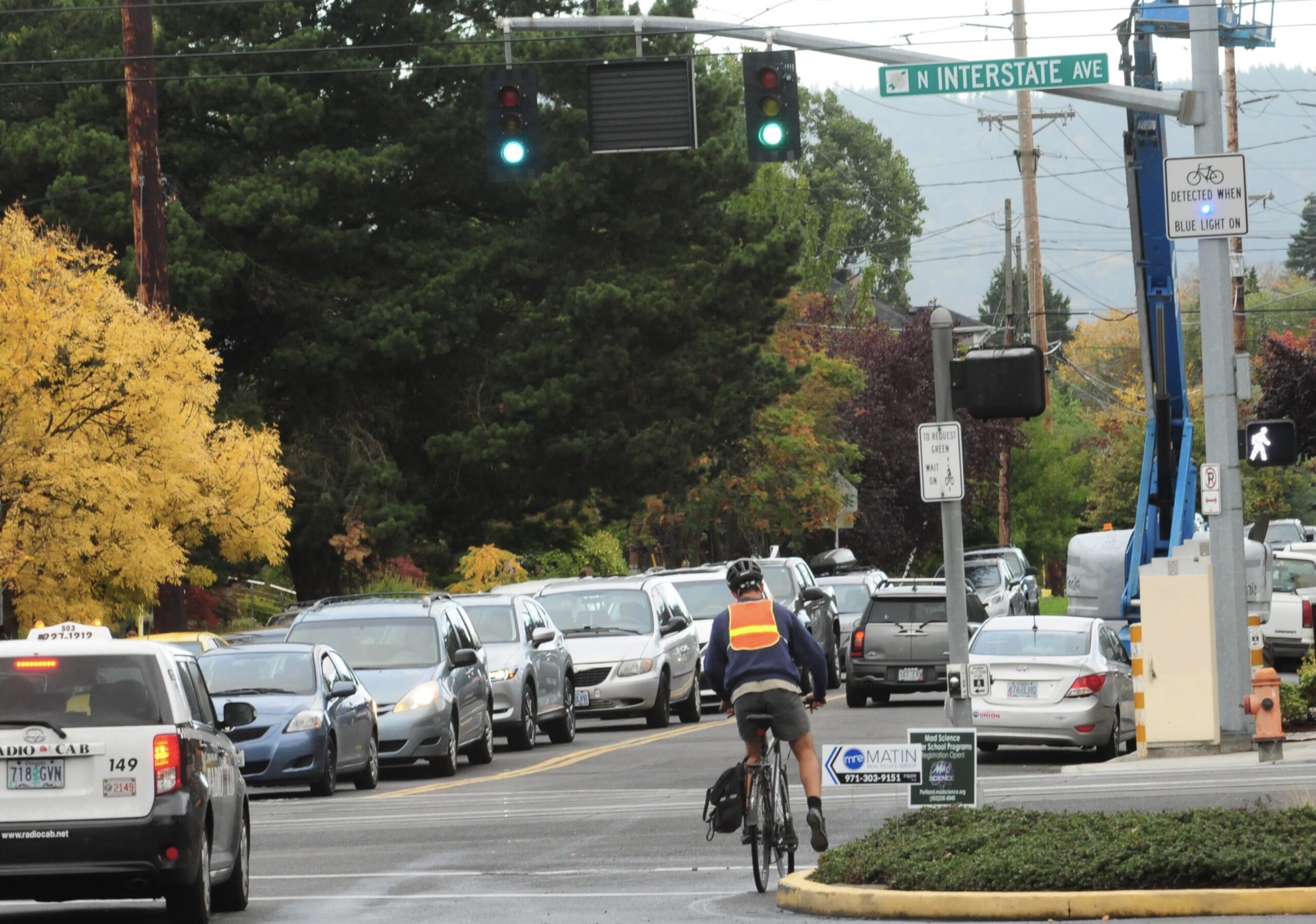
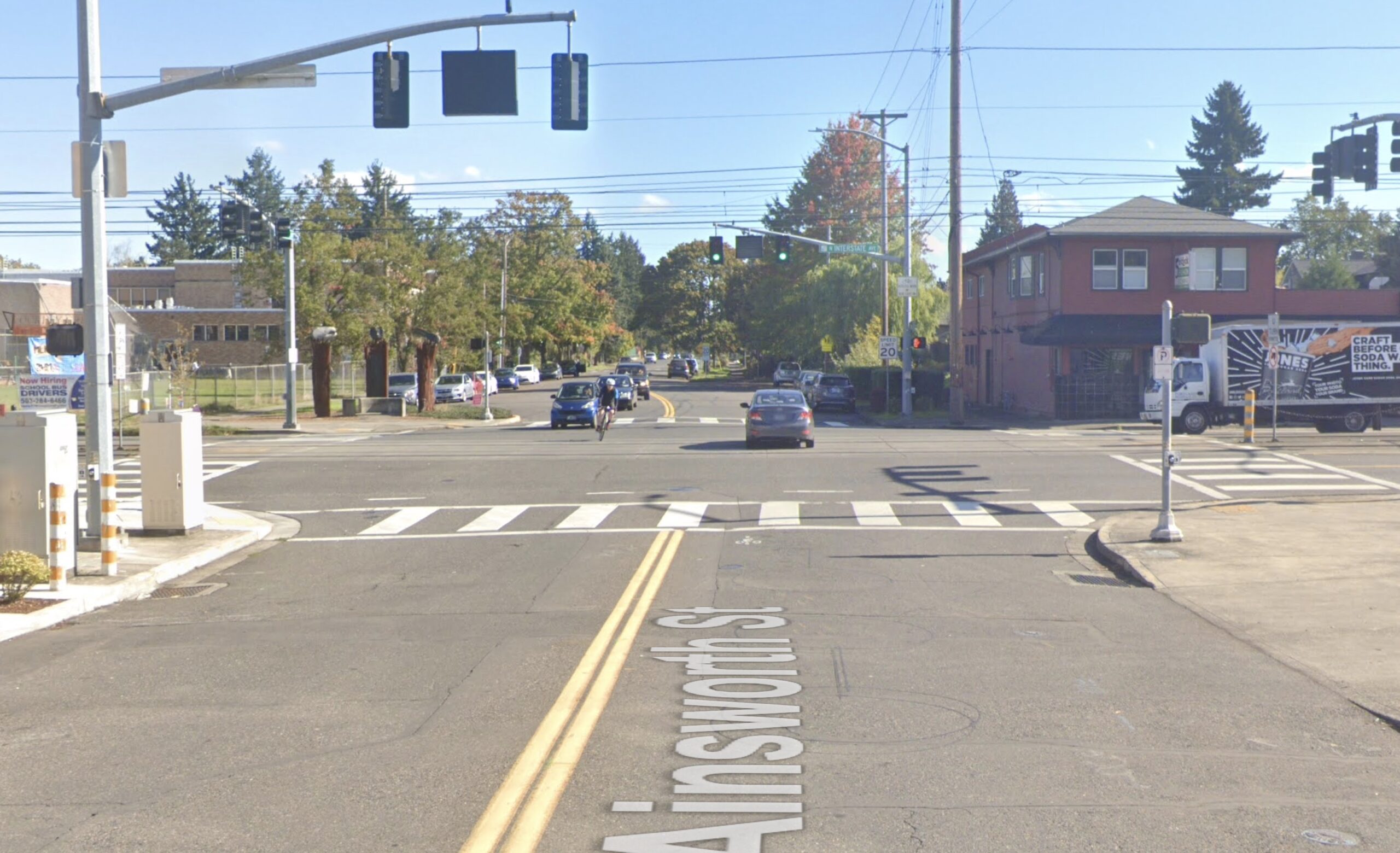
Ainsworth is an interesting street in this area. It’s not particularly bike-friendly, but people like it because it connects directly to the (north-south) Michigan and Concord neighborhood greenways and the Williams Ave bikeway. It’s also the best, southernmost connection to the serene vibes and views on Willamette Blvd (which connects to St. Johns and points beyond). One of the stressful things about Ainsworth is that riders share a roadway with car drivers. Despite the 20 mph speed limit, the lack of dedicated cycling space and design characteristics (on-street parking and relatively narrow curb-to-curb width) can make it feel unsettling — especially for families and “interested but concerned” riders.
PBOT has taken note of the valuable role Ainsworth plays in the bike network. In 2019 they installed a special detector to help bike riders trigger the traffic signal. Unfortunately, many people using bikes don’t know how it works and still hug the curb and push the pedestrian button instead of waiting in the middle of the lane (like the person in the photo above left, and who can blame them?!). This is inconvenient and it puts bike riders at higher risk for right-hooks.
The new bike box should help promote safer behaviors at this intersection. It will be colored green, with a wide, buffered bike lane directing bike riders to the front of the traffic queue. The “No Turn on Red” signs should also help — but only if people obey them.
In addition to the bike box and turn restrictions, PBOT will also prohibit parking for 65-feet west of Interstate on the south side of Ainsworth (in front of several businesses). “This will allow people who are bicycling to move ahead of vehicles at a busy intersection,” Cohen said.
The changes will help not only the bikeway, but should lead to a calmer intersection overall for kids and families walking to the school and other destinations in the area.
Construction is expected to begin as early as this month or later this fall and be completed before the end of the year.




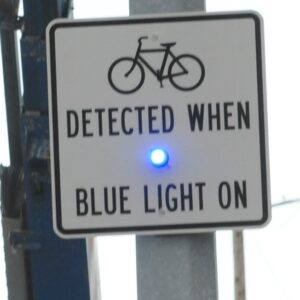
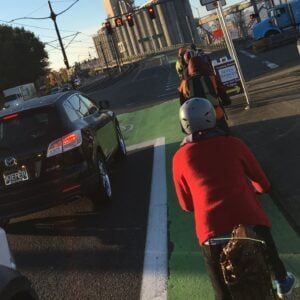

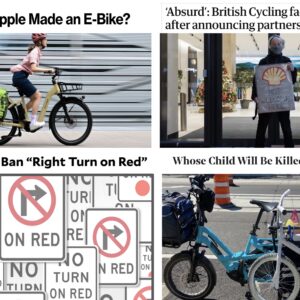
Thanks for reading.
BikePortland has served this community with independent community journalism since 2005. We rely on subscriptions from readers like you to survive. Your financial support is vital in keeping this valuable resource alive and well.
Please subscribe today to strengthen and expand our work.
My daily commute route has multiple bike boxes and >90% of the time drivers enter the box. In my experience, this is a post-2020 behavior and speaks to the increasing SUV-centrism of this dysfunctional and grossly unequal city.
I agree. There are several no right on red intersections in SW Portland that I often see ignored. For the past month there has been a new no left turn with enormous signs and multiple arrows and people still do that, too. Maybe they’re mindlessly following their Google directions.
We’ve had 2+ years of zero traffic enforcement in this city. People do it because they know they will get away with it.
I disagree. I go through the box at SE Lincoln/Chavez nearly every day, have been for years, and I’d say compliance there is about 90%, maybe better. Makes me wonder if PBOT has looked at bike box compliance? Seems like it’d be a good thing to have a handle on.
This will definitely be a welcome improvement. I used to bike on ainsworth frequently, and the interstate intersection was one of several stress points.
Thank you for pointing out that no turn on red signs only work if drivers comply. They are frequently ignored, and I don’t see police out enforcing them.
Educating bicyclists about triggering the sensor loops has been an ongoing problem for decades. Decades ago when the Burnside Bridge was closed to auto traffic and we had a bike event on the bridge, PBOT had a portable sensor loop and traffic light demonstration. Cyclists would ride up on the platform and the traffic light would turn green. They were showing that it worked for non-ferrous bikes and even non-metal bikes if you placed the wheel hub over the sensor. It was mind opening for me. Since then, I have tried to tell bikers that this feature exists (sometimes even with a blue light signal across the intersection indicating the sensor is working) but too frequently am treated as unwanted information. Cities are machines, and knowing how to operate the machine is imperative to efficiency and confidence.
The problem is that many loops in Portland are not sensitive enough to detect lighter bike rims. Peter Koonce acknowledged that they use heavy hybrid/mountain-bike rimmed wheels for sensitivity adjustment so less heavy rims are often not detected under real-world conditions.
(And, of course, crabon fibre rims are not detectable at all.)
My experience is that many of the loops will detect even a hub of a wheel. It becomes critical however to place the wheel accurately. The other hack is to lay the bike over so the hub is close to the ground to trigger the signal.
Jonathan Maus–Perhaps this might make a nice informational article? How sensitive are the loops? Do they work on plastic bikes? Do they work with plastic, lightweight bikes if you hold the hub near the ground over the loop? Why are there not more blue indicator lights to let the bikers know the waiting is productive? Do other cities tune the loops for bikes? I bet you have a good contact with a PBOT traffic engineer. I see a lot of confusion over this infrastructure by bike riders.
Your experience is likely influenced by your bike’s components.
For example, my e-bike with a heavier alloy rim and hub reliably activates induction loop detectors. Commuter A has crabon fibre wheels, flimsy butted spokes, and teensy metal hubs and rarely triggers induction loop detectors. Commuter B has lightweight Belgium C2 rims + XTR hubs and triggers ~80% of induction loop detectors.
(Of course, if I lean over in an extreme fashion or place the crank on the pavement I can always trigger the detector on commuters A and B. However, most of the time I avoid this embarrassing induction loop dance by running the light or hitting the beg button.)
I have been to some rural Washington County lights that have no crosswalk button, but the light is controlled by a loop system. The only option for a walker or other metal-light road user to change the signal is to either wait for a motor vehicle to trigger the loop, run the light (which may even be LEGAL in this case), or know the trick of using the metal you bike has to trigger the sensor. At any rate, I would love to hear from an actual expert on how they are handling the issue.
I also have noted, Soren, that you may be a fan of Bike Snob with your spelling of carbon (crabon).
Ainsworth has been a sour spot for a lot of North Portland bike users. It consistently has bike counts above many neighborhood greenways and many other ‘major city bikeways’ as classified in PBOT’s TSP. Yet it still lacks even the smallest amount of protection from vehicle traffic or diversion of vehicles.
For bike users, Its really the first viable E-W connector for peninsula bound folks going up Williams. Its also the safest way to cross I5. However, it’s also the fastest way to cross I5 for vehicles, so cars end up using Ainsworth to skirt the actual nearby collector street overpasses (Rosa Parks or Killingsworth).
At the end of the day: Ainsworth needs a lot more attention, but the bike boxes are a good start to see from PBOT